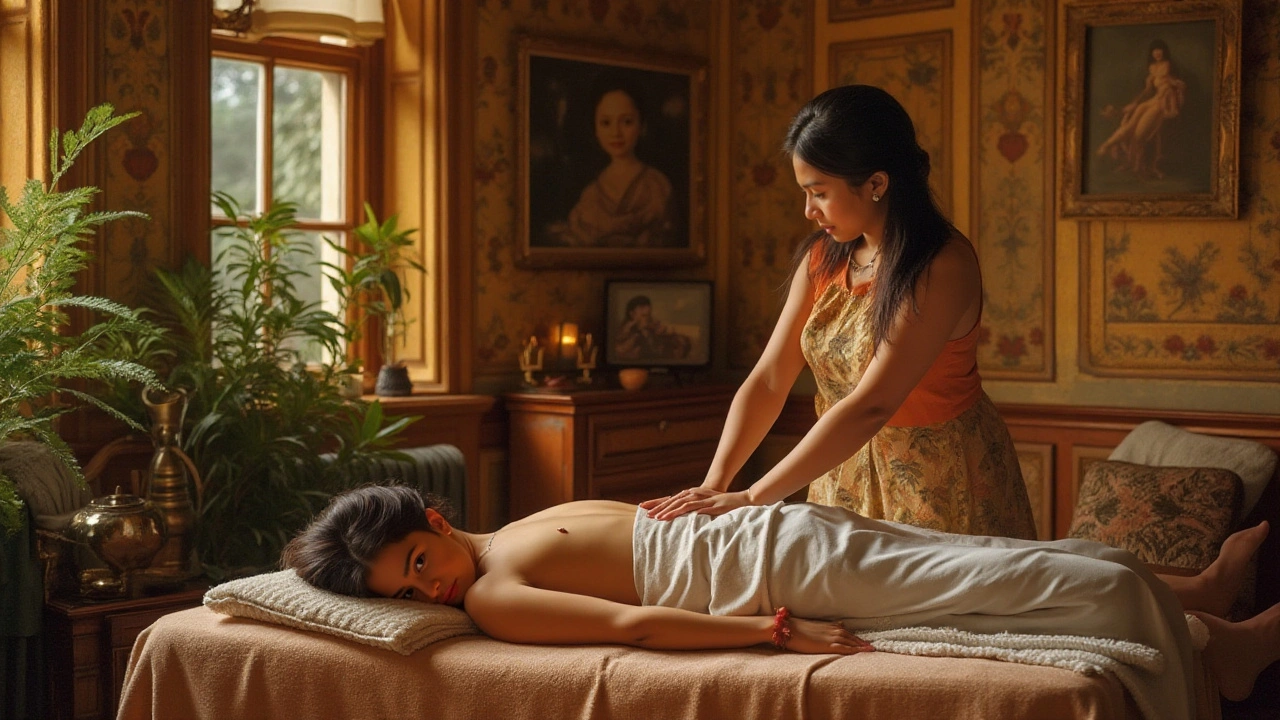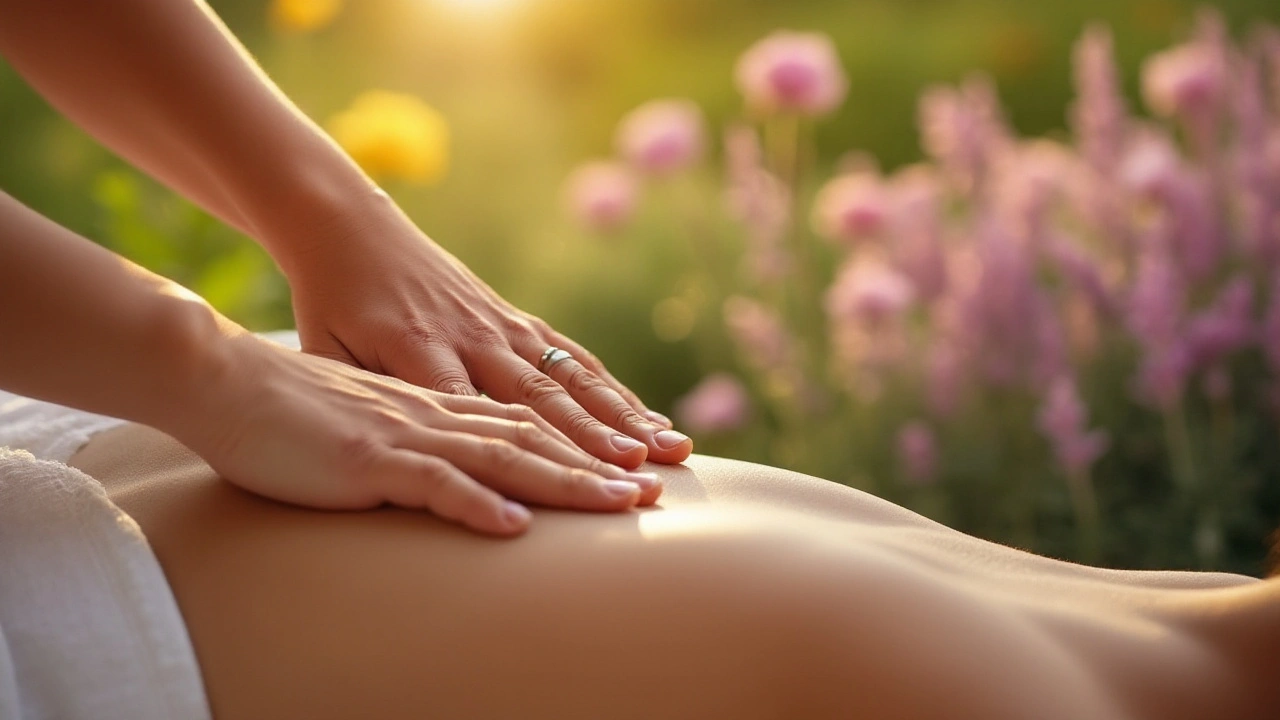Discover the Magic of Thai Massage for Your Ultimate Self-Care Session
 Feb, 4 2025
Feb, 4 2025
In the bustling arena of modern self-care, Thai massage emerges as a timeless tradition imbued with depth and authenticity. Beyond the typical spa offerings, this ancient practice weaves together elements of yoga and acupressure with a rich cultural heritage, creating a therapeutic experience unlike any other. Accessible and deeply impactful, Thai massage is more than a remedy for tense muscles—it invites you into a world where relaxation, rejuvenation, and holistic well-being come alive.
Now, picture this: a serene setting, the gentle guidance of a skilled practitioner, and a dance of stretches and compressions that feels tailored just for you. As you explore the layers of this practice, you'll find yourself unraveling not just physical knots, but also mental and emotional stresses. So why settle for the mundane when you can indulge in a transformative journey that embraces your entire being? Welcome to the world of Thai massage—your next essential self-care experience awaits.
- The Ancient Roots and Philosophy of Thai Massage
- Techniques and Methods that Set Thai Massage Apart
- The Multifaceted Benefits for Body and Mind
- Incorporating Thai Massage into Your Self-Care Routine
- Finding the Right Practitioner and Setting
The Ancient Roots and Philosophy of Thai Massage
Steeped in history and tradition, Thai massage is not merely a technique, but a profound cultural expression that dates back over 2,500 years. This holistic healing practice traces its origins to ancient Thailand, where it evolved from a blend of Chinese, Indian, and Southeast Asian healing traditions. Central to its philosophy is the belief in unseen energy lines, known as "Sen lines," which form the foundation of its therapeutic approach.
The legendary figure credited with establishing Thai massage is Shivago Komarpaj, who was purportedly a contemporary and close friend of the Buddha. According to tradition, he was a renowned physician whose teachings laid the groundwork for this healing modality. With time and through generations, these teachings have been preserved and passed down, continuously evolving to incorporate local knowledge and practices.
Core to Thai massage is the concept of balance — both of the body and the mind. The practice operates on the principle that blockages or imbalances in the body's energy flow can lead to disease and discomfort. By applying targeted pressure along the Sen lines and using synchronized stretching movements, practitioners aim to restore harmony, promoting physical and energetic well-being.
According to traditional Thai medicine, “The human body is seen as an intricate web of interconnected systems, where equilibrium signifies health, and disharmony leads to illness.”
The Spiritual and Cultural Context
Beyond its physical benefits, Thai massage carries deep spiritual significance, often performed as a meditative dance between therapist and client. It is considered a compassionate practice—an act of "Metta," or loving-kindness, which is a fundamental aspect of its philosophy. This aligns it with Buddhist principles, underscoring the importance of mindfulness and presence.
The ability of Thai massage to invoke a state of deep relaxation while also energizing the receiver is attributed to this spiritual context. Simultaneously gentle and firm, it fosters an experience where both body and mind find respite. It is no wonder that practitioners often describe it as "assisted yoga."
Preservation and Global Reach
Today, Thai massage has transcended its eastern borders, finding enthusiasts worldwide who embrace its revitalizing effects. In fact, it has become a staple in wellness regimens globally. Thailand remains the heart of this practice, where practitioners continue to hone their skills through rigorous training in revered institutions such as Wat Pho, the Temple of the Reclining Buddha in Bangkok.
With its deep roots and rich philosophy, Thai massage stands as a timeless testament to the power of holistic and cultural healing—a heritage treasure that beautifully bridges tradition with modern self-care practices.
Techniques and Methods that Set Thai Massage Apart
At the heart of Thai massage lies a uniquely dynamic approach that marries elements of acupressure, Ayurveda, and assisted yoga postures. Unlike Western massage styles, which commonly involve direct pressure on muscle tissue, Thai massage is performed on a mat or firm mattress on the floor, allowing the therapist to utilize gravity and full-body movements. This holistic method is designed to open the body's energy lines, called 'Sen', which are rooted in ancient Thai medicine.
The Art of Rhythmic Motion
One of the most distinctive elements of Thai massage is its rhythmic, almost dance-like flow. The practitioner uses their hands, feet, elbows, and knees to apply firm pressure and encourage stretching. This flow serves to boost circulation, enhancing energy flow throughout the body. By incorporating principles similar to yoga, clients often experience increased flexibility and release of tension not just physically but also mentally.
Pressure Point Techniques
Thai massage emphasizes acupressure techniques that target specific points on the body. These pressure points are massaged and manipulated to facilitate detoxification and energy balancing. Experienced therapists will adjust pressure according to personal tolerance and therapeutic need, making the massage highly individualized. The stimulation of these points is known to enhance the body's natural healing systems.
Engaging the Sen Lines
The concept of Sen lines in Thai massage acts as a blueprint for achieving equilibrium within the body. Though there are said to be over 72,000 Sen lines, practitioners often focus on ten major lines considered vital for wellbeing. By systematically working along these pathways, the flow of energy—or lom—is unblocked, addressing internal disharmony.
"Thai massage is like a dance, with the therapist leading you into a meditative state where healing begins," shares Somchai Lertprajak, a well-respected expert from the Wat Pho Traditional Medical School in Bangkok.
Yoga-Like Stretching
A key component of every Thai massage session is the inclusion of yoga-like stretching and joint manipulation. The therapist facilitates an environment where passive stretching occurs naturally with the intent to improve flexibility over time. This component often leads to an increase in the client's bodily awareness, helping them maintain a better posture and feel more energized.
What to Expect from Your Session
- Wear comfortable, loose-fitting clothing to allow for unrestricted movement.
- A session typically lasts 60 to 120 minutes, depending on your needs and comfort.
- Be prepared for a full-body experience—it's an active massage where participation enhances the benefits.
Thai massage is an art form that extends beyond physical touches. Its elegant blend of techniques nurtures an incomparable harmony between body and mind, making it a profound choice for anyone looking to dive into a world where self-care becomes an act of holistic healing.

The Multifaceted Benefits for Body and Mind
Thai massage is a distinctive practice that offers an array of benefits for both the body and mind, making it a compelling choice for those seeking a holistic wellness experience. Anchored in centuries of tradition, this versatile massage technique focuses on balancing energy flow through intricate movements and expert touch.
Enhancing Physical Flexibility and Strength
One of the most celebrated advantages of Thai massage is its profound impact on physical flexibility. Utilizing a combination of assisted yoga postures, rhythmic compressions, and gentle stretches, Thai massage effectively elongates muscles and improves joint function. Regular sessions contribute to increased range of motion and muscular flexibility, which are especially beneficial for athletes and individuals with physically demanding lifestyles.
Promoting Deep Relaxation and Stress Relief
In a world where stress has become an almost constant companion, Thai massage offers a sanctuary of calm. The rhythmic flow and mindful application of pressure help to soothe the nervous system, reducing tension and inducing relaxation. It is not just the physical aspect that contributes to serenity; the practice's cultural roots in meditation and mindfulness provide a potent antidote to modern-day stressors.
"Thai massage is akin to a tranquil dance, one where the practitioner skillfully guides the recipient into a state of mental and emotional equilibrium," says Dr. Niran Sornprasart, a well-regarded expert in traditional Thai medicine.
Boosting Energy Levels and Circulation
Energy lines, known as Sen, are a core concept in Thai massage. By applying targeted pressure along these pathways, practitioners can help release blockages, thereby enhancing the body's natural energy flow. Improved circulation is often an immediate outcome, with many clients reporting a noticeable increase in energy post-session. Such revitalization is key for those who often feel fatigued or lack vitality.
Supporting Mental Clarity and Emotional Balance
The mental benefits of Thai massage are just as noteworthy. The mindful nature of the practice encourages an introspective experience, allowing individuals to disconnect from their busy minds. The result is often a sense of heightened mental clarity and emotional stability. Those struggling with anxiety or a hectic lifestyle may find particular solace here, as the massage fosters a meditative state that calms the mind and nurtures the spirit.
Tailored Benefits for a Personalized Journey
No two Thai massage experiences are exactly the same, as each session is often customized to the client's needs. Practitioners adapt their techniques to focus on specific areas of tension or imbalance, ensuring that each massage is as unique as the individual receiving it. This bespoke approach is one of the reasons Thai massage continues to attract a diverse clientele, all searching for personal respite and rejuvenation.
Incorporating Thai Massage into Your Self-Care Routine
Integrating Thai massage into your self-care routine is akin to inviting a tranquil spa experience into your everyday life. But where do you start, and how can you ensure it becomes a consistent, enriching aspect of your wellness journey? Let's explore some practical steps and insights.
Setting the Stage for Relaxation
First, recognize that the environment plays a critical role in mindfulness and relaxation. Create a dedicated space at home for your self-care activities. Consider elements like soft lighting, calming music, and comfortable mats to set the ambiance. This space becomes a sanctuary where you can enjoy the therapeutic benefits of Thai massage.
Scheduling Regular Sessions
Consistency is key. Just like yoga or meditation, Thai massage should be incorporated regularly into your routine. Whether you choose to visit a professional once a month or practice some basic techniques at home weekly, setting a schedule ensures that it becomes a habit. Keep in mind that while professional sessions offer expert guidance and depth, at-home practices can complement these visits and maintain wellness between appointments.
Learning Basic Techniques
While full sessions with a practitioner offer comprehensive benefits, learning a few simple techniques can be empowering. Consider enrolling in a workshop or watching tutorials that teach how to apply gentle pressure or stretches. These skills can soothe minor aches and serve as a quick destressor after long days.
Finding the Right Practitioner
When selecting a practitioner, research is crucial. Look for certified professionals with a good reputation. Personal recommendations and online reviews can help guide your choice. Remember, the right practitioner should not only possess technical skills but also offer a comforting and intuitive approach tailored to your individual needs.
Benefits to Look Forward To
| Benefit | Description |
|---|---|
| Flexibility | Regular sessions improve joint mobility and elasticity. |
| Energy Flow | Enhances overall energy circulation through the body's meridians. |
| Stress Relief | Promotes a profound sense of calm and relaxation. |
In the words of holistic wellness expert, Dr. Meghan Williams,
"Thai massage is an art of energy balance; a true remedy for modern life's chaos."By bringing this practice into your routine, you're not just indulging in a treatment—you're making a commitment to ongoing well-being.
Thai massage isn't merely an indulgence; it is a pathway to a healthier you. So, embark on this journey of self-care and experience the myriad benefits that this ancient practice has to offer.

Finding the Right Practitioner and Setting
Embarking on a Thai massage journey involves more than just choosing any available therapist; it requires selecting a practitioner who is not only skilled but also truly understands the essence of this ancient art. The right practitioner can transform a routine session into a profound experience of healing and relaxation. But how do you find the right fit for you?
Essential Qualities of a Skilled Thai Massage Practitioner
Look for practitioners who have undergone formal training at reputable institutions, such as the Wat Po Thai Traditional Medical School in Bangkok. This ensures they are versed in the intricate techniques specific to Thai massage. Experience matters too; practitioners with years of practice tend to intuitively gauge your body’s needs, adjusting techniques to suit you.
"A good therapist will always teach you to listen to your body and respect its limits," notes Dr. Somsak Boontiam, a prominent figure in Thai massage education.
Observe their ability to communicate. As Thai massage involves various pressure levels and stretches, clear communication is crucial for both safety and comfort. A practitioner open to feedback will enhance your experience, preventing discomfort, guiding you through an enriching session.
The Ideal Setting for a True Thai Massage Experience
The environment plays a pivotal role in the efficacy of your session. Seek out spaces that exude calm and tranquility. Traditional settings often incorporate elements like bamboo mats or futons on the floor, invoking the authentic Thai ambiance. Aromatherapy scents can further enrich the atmosphere, aligning your senses with the experience.
Consider the cleanliness and organization of the space, as these are tell-tale signs of professionalism. A serene backdrop, combined with soothing sounds or soft music, can further deepen relaxation, creating an oasis away from your daily grind.
Is Certification Necessary?
In many countries, certification for Thai massage therapists is a requisite, serving as a benchmark for skill and knowledge. While not all regions mandate this, choosing certified practitioners assures you of regulated training and standards.
| Region | Certification Body |
|---|---|
| United States | National Certification Board for Therapeutic Massage & Bodywork (NCBTMB) |
| Thailand | Ministry of Public Health's Department for Development of Thai Traditional and Alternative Medicine |
Checking credentials with governing bodies can often direct you to the most trusted practitioners in your area.
Ultimately, investing time in finding a practitioner and setting that aligns with your needs can greatly enhance the therapeutic benefits of your Thai massage experience. It's not just a matter of getting a massage—it's about entering into a sanctuary where restoration and renewal are the core focus.
